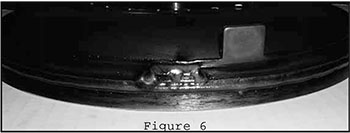Indexing TCC Piston/Damper Assemblies to Turbines
Ed Lee
At a recent TASC Force meeting, one of the members expressed concern about an increase in the number of worn-out bores in TCC pistons that he was seeing. Although the problem is prevalent in many different pistons, his main focus was on theGM.298mmpistons. He went on to clarify: The worn-out bores were not being found on OE converters that were coming in for rebuild. The problem was only happening on previously rebuilt converters. The general consensus was that the problem was caused by an out-of-balance condition, and there was a great deal of speculation about why this was happening.
When the OEMs build a converter, they balance the turbine and the clutch individually to a tolerance of 1 gram-inch. The two components are then mated together, with the heavy spot of the turbine indexed directly opposite the heavy spot on the clutch. On the 298mm GM converter, the heavy spot on the turbine is located where the balance weight was added. This spot is marked with a paint dab at the factory (seeFigure 1).
 |
 |
The paint dab is usually light gray in color, but unfortunately, the paint dab usually disappears the first time the part is cleaned in a pressure washer. Remember that the turbine is balanced to a tolerance of 1 gram-inch or less, so the heavy spot will be from 0 to 1 gram heavier. The heavy spot on the TCC clutch is located where the notches of metal were removed from the skirt of the piston for balance purposes (seeFigure 2).
由于离合器与涡轮机相同的耐受性,因此在此点也将在0到1克较重的情况下。两部分索引在一起并作为一个单元平衡。如果他们现在平衡到1克或更少,则单位还可以。如果平衡超过1克挤出1克,则离合器旋转一个花键左或右和重新平衡。如果余额现在在规格中,则单位还可以。但是,如果在离合器旋转时平衡单元所需的重量,则离合器旋转到相反方向并重新平衡。
 |
 |
工厂希望将沉重的斑点与直接相反的45°以内。您将很少看到涡轮机和离合器,距离直接相反的25°以上。这种涡轮机和离合器的平衡的机器是完全自动化的。在机器上完成将重量与涡轮机的重物焊接并从离合器铣削重物。真正显着的部分是,这项工作以每小时约120份的速度完成。
大约500和518 TCC活塞具有像在298mm GM涡轮机上看到的涂料表达。涂料DAB可以是离合器的前侧或背面,并对涡轮机的重量相对。518活塞Figure 3背面有涂料涂料。

On the Cummins TCC clutch the heavy spot is marked with a stamped arrow (seeFigure 4).
You may have noticed that the wear in the bore of the Cummins piston is always on the side of the bore that is opposite the notches in the piston and the arrow.
On some of the import TCC pistons you may find an ink dab marking the heavy spot.Figure 5is a good example of this on a Honda TCC clutch. The weight on a Honda turbine is indexed on the opposite side (seeFigure 6).
Since most pressure washers are not ink spot or paint dab friendly, scratching an “X” across the paint or ink dab would be a good habit to cultivate. This is especially helpful if the original part is less than 1 gram-inch out of balance and no modification is necessary (no weight added, no weight removed).
 Since the turbine and the clutch each can be as much as 1 gram-inch heavy on a side and still be within specs, if the two heavy spots are both on the same side, the turbine/clutch unit could be as much as 2 gram-inches out of balance. This could explain the worn-out bores in the clutches.
Since the turbine and the clutch each can be as much as 1 gram-inch heavy on a side and still be within specs, if the two heavy spots are both on the same side, the turbine/clutch unit could be as much as 2 gram-inches out of balance. This could explain the worn-out bores in the clutches.
A good rule of thumb is to index the heavy spot of the turbine (where the weight is added) opposite the heavy spot of the clutch (where the weight has been removed). This will prove beneficial even if your shop doesn’t have a balancer.
Special thanks to Jim Beattie of ATI and Maura Stafford
of Sonnax for their technical assistance in writing this article.
Ed Lee is a Sonnax Technical Specialist who writes on issues of interest to torque converter rebuilders. Sonnax supports thebob游戏怎么下载Torque Converter Rebuilders协会.
Related Units
While Sonnax makes every effort to ensure the accuracy of technical articles at time of publication, we assume no liability for inaccuracies or for information which may become outdated or obsolete over time.